Until about two decades ago, on clear sunny days and from certain strategic locations, Nairobi residents could catch a glimpse of Africa’s two highest mountains – Mount Kenya in the north and Mount Kilimanjaro in the south, both located some 200 kilometres from the city. The view was spectacular: It captured two majestic mountains in two neighbouring countries, and both mountains were covered in snow, an unusual phenomenon for mountains located so near the Equator.
But such sights are rare these days. Air pollution in and around Nairobi has significantly reduced the visibility of the mountains from the city. And when they can be seen, long-term residents note the significantly diminished amount of snow. Melting glaciers and reduced snowfall on both mountains have raised concerns about the impact of global warming on East Africa’s most scenic mountain ranges.
The iconic Mount Kilimanjaro in Tanzania has attracted both tourists and mountain climbers, who have been mesmerised by the its gentle slopes, large glaciers, and snow caps. But the snows of Kilimanjaro could disappear within the next decade. One study found that Kilimanjaro’s ice fields have shrunk by about 85% in the past 100 years, from 12 square kilometres to just 1.85 square kilometres. Mt Kenya’s largest glacier has shrunk by 90% since 1934, according to studies.
Climate change has hit Africa harder than other regions
Seven out of 10 countries considered most vulnerable to climate change are in Africa. But the continent has contributed the least to global warming. Africa produces less than 4% of global CO2 emissions, but has suffered most severely from their impact. The continent is particularly vulnerable to climate variability and change because of high poverty levels and agriculture that is heavily dependent on rainfall.
“If current retreat rates prevail, the African mountains will be deglaciated by the 2040s. Mount Kenya is likely to be deglaciated a decade sooner, which will make it the one of the first entire mountain ranges to lose glaciers due to anthropogenic climate change,” says the “State of the Climate in Africa 2020,” a joint report by the World Meteorological Organization (WMO), other UN agencies, the African Union, and experts from Africa and partner international scientific and technical institutions.
The pace of the shrinkage appears to have accelerated in the past 20 years, mainly due to altered sea-surface temperature patterns across the Indian Ocean, which have reduced the amount and frequency of rain on the mountains and melted the glaciers.
Additionally, Africa’s land mass has warmed faster than other regions of the world. Temperatures in all African subregions were higher in the 1991-2020 period than in the 1961-1990 period and significantly higher than in the 1931-1960 period. The greatest temperature rises were recorded in the north-west of the continent, in western equatorial areas and in parts of the Greater Horn of Africa.
Rising land and sea temperatures are leading to reduced rainfall in many countries, which is impacting farming and food security. Global warming is causing areas that already get significant rainfall (such as the equatorial and subpolar rain belts) to get more rain, while areas that get little rain (such as subtropical dry zones) to get even less rain.
Rising food insecurity
Crop failure due to insufficient or excessive rain can be devastating for African small-scale farmers, the majority of whom practise rain-fed agriculture. This has led to rising food insecurity in some parts of the continent. Agriculture contributes a large proportion of many African countries’ GDP – but climate change could lower GDP in sub-Saharan Africa by up to 3%.
Almost 98 million people in Africa suffered from food insecurity in 2020. That marked an increase of almost 40% from 2019, according to the World Food Programme’s “Global Report on Food Crises 2021.” Increasing food insecurity is partially attributed to the COVID-19 pandemic, which led to significant job losses and reduced incomes in most countries.
However, the pandemic is not the only reason for increasing food insecure in some African countries. Protracted conflicts, poor rainfall, locust invasions, and increasing desertification have further compounded the crisis. Some of the worst affected countries are the Democratic Republic of the Congo, Sudan, northern Nigeria, Ethiopia, South Sudan, and Somalia.
Extreme weather events have also led to loss of species and ecosystems, which are impacting agricultural and fishing yields. Droughts, floods, and storms also destroy crops and spread diseases. Floods and storms create breeding grounds for mosquitos and contaminate drinking water, which lead to the spread of diseases such as malaria and cholera.
The need for warning systems and investments
Weak early warning systems and poor access to weather-related information make it more difficult for African populations to respond to impending crises. Early warning systems that incorporate risk assessment, monitoring and predicting, disseminating and communicating warnings, and taking appropriate actions to reduce the impact of disasters have proved effective in dealing with the negative effects of climate change. Household surveys by the IMF in Ethiopia, Malawi, Mali, Niger, and Tanzania found that broadening these systems and improving access to information could reduce food insecurity by up to 30%.
In order to mitigate the impact of climate change on African countries, more investment is needed in prevention, preparedness, disaster risk reduction, policy engagement, legal guidance, and data collection and analysis. Africa may need investments of over $3 trillion in mitigation and adaptation by 2030 to support climate change action, according to the African Financial Alliance on Climate Change. But this challenge also represents tremendous opportunities for private sector investors, especially those interested in renewable energy.
“Africa’s financial actors need to work together creatively to mobilise global financial resources at scale that can support local innovation, and that drives climate-resilient and low-carbon development on the continent. Having been short-changed by climate change, Africa must not be short-changed by climate finance,” says African Development Bank President Akinwumi Adesina.
Stay informed
For more on the health, economic, and social impacts of COVID-19 in Africa, check out ONE’s Africa COVID-19 Tracker. It pulls together the latest real-time data from global institutions, governments, and universities about the impacts of the pandemic for the continent and for every African country – including information on food security. For more insights and analysis, sign up for our Aftershocks newsletter and follow us @ONEAftershocks.
Rasna Warah is a Kenyan writer and journalist who is working with the ONE Campaign’s COVID-19 Aftershocks project.



